Modeling and Implementation of a Joint Airborne Ground Penetrating Radar and Magnetometer System for Landmine Detection
Abstract
1. Introduction
- Reduced penetration depth in highly conductive or lossy soils: GPR relies on the propagation and reflection of electromagnetic waves to detect buried objects. However, in soils with high conductivity or high dielectric losses, such as clayey or wet soils, the penetration depth of GPR signals can be significantly reduced. This limitation can hamper the detection of landmines buried at greater depths, particularly in challenging soil conditions.
- Sensitivity to surface clutter and rough terrain: GPR signals can be affected by surface clutter, such as vegetation, rocks, or surface irregularities. Such clutter can scatter the electromagnetic waves, leading to signal distortion or interference and potentially causing false positives or false negatives. Additionally, rough terrain with uneven surfaces can impact the coupling between the GPR antenna and the ground, affecting the quality and accuracy of the collected data.
- High data processing and analysis requirements: GPR generates large volumes of data due to its high-resolution imaging capabilities. Processing and analyzing these datasets can be computationally intensive and time-consuming, requiring sophisticated algorithms and significant computational resources. Efficient data processing techniques are essential to handling large datasets and accurately extracting meaningful information for landmine detection.
- Limited detection range: MAGs are primarily sensitive to metallic objects and their magnetic anomalies. While this makes them highly effective in detecting metallic landmines, their detection range is limited compared to GPR. The magnetic field strength decreases rapidly with the third power of the distance, resulting in reduced detection capabilities for buried metallic objects at greater depths.
- Susceptibility to environmental interference: MAGs are susceptible to environmental magnetic interference, such as variations in the Earth’s magnetic field caused by geological structures or nearby ferrous objects, or the electromagnetic interference (EMI) noise that UAVs generate. These interferences can distort the measurements and lead to false positives or false negatives, compromising the accuracy of landmine detection.
- Lack of imaging capabilities: unlike GPR, which provides high-resolution images of buried objects, MAGs typically measure magnetic anomalies as scalar quantities. This lack of imaging capability makes it challenging to accurately locate and visualize the exact shape and orientation of detected landmines. Consequently, additional techniques or sensor modalities may be required to precisely determine the spatial characteristics of detected objects.
2. Materials and Methods
2.1. The UAV-Borne GPR Model
2.2. The UAV-Borne MAG Model
3. Results
3.1. Simulation Results of the UAV-Borne GPR Model
- The pressure pad (green area in Figure 4), characterized as PVC by a relative dielectric constant of 3.3 and a thickness of 13 mm;
- An air layer representing the internal structure (white area in Figure 4) with a thickness of 10 mm;
- The minimum-metal component (black area in Figure 4) is characterized as a thin step plate by PEC with a thickness of 2 mm;
- The main body of the M19 landmine (grey area in Figure 4) characterized PVC by a relative constant of 3.3 and a thickness of 75 mm.
3.2. Simulation Results of the UAV-Borne MAG Model
3.3. Experimental Results of the UAV-Borne GPR and MAG Model
4. Discussion
5. Conclusions
Author Contributions
Funding
Data Availability Statement
Conflicts of Interest
References
- Cerquera, M.R.P.; Montaño, J.D.C.; Mondragón, I.; Canbolat, H. UAV for landmine detection using SDR-based GPR technology. In Robots Operating in Hazardous Environments; IntechOpen: London, UK, 2017; pp. 26–55. [Google Scholar]
- Šipoš, D.; Gleich, D. A lightweight and low-power UAV-borne ground penetrating radar design for landmine detection. Sensors 2020, 20, 2234. [Google Scholar] [CrossRef] [PubMed]
- Burr, R.; Schartel, M.; Schmidt, P.; Mayer, W.; Walter, T.; Waldschmidt, C. Design and Implementation of a FMCW GPR for UAV-based Mine Detection. In Proceedings of the 2018 IEEE MTT-S International Conference on Microwaves for Intelligent Mobility (ICMIM), Munich, Germany, 15–17 April 2018; pp. 1–4. [Google Scholar]
- Garcia-Fernandez, M.; Alvarez-Lopez, Y.; Las Heras, F. Autonomous airborne 3D SAR imaging system for subsurface sensing: UWB-GPR on board a UAV for landmine and IED detection. Remote Sens. 2019, 11, 2357. [Google Scholar] [CrossRef]
- Schartel, M.; Burr, R.; Bähnemann, R.; Mayer, W.; Waldschmidt, C. An experimental study on airborne landmine detection using a circular synthetic aperture radar. arXiv 2020, arXiv:2005.02600. [Google Scholar]
- Fernández, M.G.; Narciandi, G.Á.; Arboleya, A.; Antuña, C.V.; Andrés, F.L.-H.; López, Y.Á. Development of an Airborne-Based GPR System for Landmine and IED Detection: Antenna Analysis and Intercomparison. IEEE Access 2021, 9, 127382–127396. [Google Scholar] [CrossRef]
- Yoo, L.-S.; Lee, J.-H.; Ko, S.-H.; Jung, S.-K.; Lee, S.-H.; Lee, Y.-K. A drone fitted with a magnetometer detects landmines. IEEE Geosci. Remote Sens. Lett. 2020, 17, 2035–2039. [Google Scholar] [CrossRef]
- Yoo, L.-S.; Lee, J.-H.; Lee, Y.-K.; Jung, S.-K.; Choi, Y. Application of a drone magnetometer system to military mine detection in the demilitarized zone. Sensors 2021, 21, 3175. [Google Scholar] [CrossRef] [PubMed]
- Dobrovolskiy, A. Detection and Localization of Ferrous Underground Objects and Buried Utilities Using Airborne Magnetometers and Metal Detectors. First Break 2021, 39, 79–85. [Google Scholar] [CrossRef]
- Joo, M.; Yoon, J.; Junejo, A.R.; Doh, J. Optimization: Drone-Operated Metal Detection Based on Machine Learning and PID Controller. Int. J. Precis. Eng. Manuf. 2022, 23, 503–515. [Google Scholar]
- Dena, A.; Ahiska, K.; Aouf, N. Image based visual servoing for landmine detection using quadrotors. In Proceedings of the 2020 15th IEEE Conference on Industrial Electronics and Applications (ICIEA), Kristiansand, Norway, 9–13 November 2020; pp. 527–532. [Google Scholar]
- Grosz, A.; Haji-Sheikh, M.J.; Mukhopadhyay, S.C. High Sensitivity Magnetometers; Springer: Berlin/Heidelberg, Germany, 2017; Volume 19. [Google Scholar]
- Fischer, C.; Wiesbeck, W. Multistatic GPR for antipersonnel mine detection. In Proceedings of the IGARSS 2001. Scanning the Present and Resolving the Future. Proceedings. IEEE 2001 International Geoscience and Remote Sensing Symposium (Cat. No. 01CH37217), Sydney, NSW, Australia, 9–13 July 2001; pp. 2721–2723. [Google Scholar]
- Mu, Y.; Xie, W.; Zhang, X. The joint UAV-borne magnetic detection system and cart-mounted time domain electromagnetic system for UXO detection. Remote Sens. 2021, 13, 2343. [Google Scholar]
- Sato, M.; Kikuta, K.; Miller, R.B. Evaluation of ALIS GPR for humanitarian demining in colombia and cambodia. In Proceedings of the 2018 International Conference on Electromagnetics in Advanced Applications (ICEAA), Cartagena, Colombia, 10–14 September 2018; pp. 114–117. [Google Scholar]
- Li, H.; Li, N.; Wu, R.; Wang, H.; Gui, Z.; Song, D. GPR-RCNN: An algorithm of subsurface defect detection for airport runway based on GPR. IEEE Robot. Autom. Lett. 2021, 6, 3001–3008. [Google Scholar]
- Hou, F.; Lei, W.; Li, S.; Xi, J. Deep learning-based subsurface target detection from GPR scans. IEEE Sens. J. 2021, 21, 8161–8171. [Google Scholar] [CrossRef]
- Chen, G.; Bai, X.; Wang, G.; Wang, L.; Luo, X.; Ji, M.; Feng, P.; Zhang, Y. Subsurface Voids Detection from Limited Ground Penetrating Radar Data Using Generative Adversarial Network and YOLOV5. In Proceedings of the 2021 IEEE International Geoscience and Remote Sensing Symposium IGARSS, Brussels, Belgium, 11–16 July 2021; pp. 8600–8603. [Google Scholar]
- Liu, Z.; Wu, W.; Gu, X.; Li, S.; Wang, L.; Zhang, T. Application of combining YOLO models and 3D GPR images in road detection and maintenance. Remote Sens. 2021, 13, 1081. [Google Scholar] [CrossRef]
- Zhang, X.; Han, L.; Robinson, M.; Gallagher, A. A GANs-based deep learning framework for automatic subsurface object recognition from ground penetrating radar data. IEEE Access 2021, 9, 39009–39018. [Google Scholar] [CrossRef]
- Akhaury, U.; Giannakis, I.; Warren, C.; Giannopoulos, A. Machine Learning Based Forward Solver: An Automatic Framework in gprMax. arXiv 2021, arXiv:2111.12148. [Google Scholar]
- Omwenga, M.M.; Wu, D.; Liang, Y.; Yang, L.; Huston, D.; Xia, T. Cognitive gpr for subsurface object detection based on deep reinforcement learning. IEEE Internet Things J. 2021, 8, 11594–11606. [Google Scholar] [CrossRef]
- Fan, L.; Kang, C.; Wang, H.; Hu, H.; Zhang, X.; Liu, X. Adaptive Magnetic Anomaly Detection Method Using Support Vector Machine. IEEE Geosci. Remote Sens. Lett. 2020, 19, 8001705. [Google Scholar] [CrossRef]
- Liu, S.; Chen, Z.; Pan, M.; Zhang, Q.; Liu, Z.; Wang, S.; Chen, D.; Hu, J.; Pan, X.; Hu, J. Magnetic anomaly detection based on full connected neural network. IEEE Access 2019, 7, 182198–182206. [Google Scholar] [CrossRef]
- Xu, X.; Huang, L.; Liu, X.; Fang, G. Deepmad: Deep learning for magnetic anomaly detection and denoising. IEEE Access 2020, 8, 121257–121266. [Google Scholar] [CrossRef]
- Ruff, L.; Kauffmann, J.R.; Vandermeulen, R.A.; Montavon, G.; Samek, W.; Kloft, M.; Dietterich, T.G.; Müller, K.-R. A unifying review of deep and shallow anomaly detection. Proc. IEEE 2021, 109, 756–795. [Google Scholar]
- Giannopoulos, A. Modelling ground penetrating radar by GprMax. Constr. Build. Mater. 2005, 19, 755–762. [Google Scholar] [CrossRef]
- Nobes, D.C. Geophysical surveys of burial sites: A case study of the Oaro urupa. Geophysics 1999, 64, 357–367. [Google Scholar] [CrossRef]
- Hamran, S.-E.; Gjessing, D.; Hjelmstad, J.; Aarholt, E. Ground penetrating synthetic pulse radar: Dynamic range and modes of operation. J. Appl. Geophys. 1995, 33, 7–14. [Google Scholar] [CrossRef]
- Soldovieri, F.; Lopera, O.; Lambot, S. Combination of advanced inversion techniques for an accurate target localization via GPR for demining applications. IEEE Trans. Geosci. Remote Sens. 2010, 49, 451–461. [Google Scholar] [CrossRef]
- Oliveira, R.J.; Caldeira, B.; Teixidó, T.; Borges, J.F. GPR clutter reflection noise-filtering through singular value decomposition in the bidimensional spectral domain. Remote Sens. 2021, 13, 2005. [Google Scholar]
- Berkhout, A. Wave field extrapolation techniques in seismic migration, a tutorial. Geophysics 1981, 46, 1638–1656. [Google Scholar] [CrossRef]
- Stolt, R.H. Migration by Fourier transform. Geophysics 1978, 43, 23–48. [Google Scholar] [CrossRef]
- Franceschetti, G.; Lanari, R. Synthetic Aperture Radar Processing; CRC Press: Boca Raton, FL, USA, 2018. [Google Scholar]
- Prager, S.; Moghaddam, M. Application of ultra-wideband synthesis in software defined radar for UAV-based landmine detection. In Proceedings of the IGARSS 2019—2019 IEEE International Geoscience and Remote Sensing Symposium; 2019; pp. 10115–10118. [Google Scholar]
- Leuschen, C.J.; Plumb, R.G. A matched-filter-based reverse-time migration algorithm for ground-penetrating radar data. IEEE Trans. Geosci. Remote Sens. 2001, 39, 929–936. [Google Scholar] [CrossRef]
- Lombardi, F.; Griffiths, H.D.; Lualdi, M.; Balleri, A. Characterization of the internal structure of landmines using ground-penetrating radar. IEEE Geosci. Remote Sens. Lett. 2020, 18, 266–270. [Google Scholar] [CrossRef]
- M: Explore UWB Radar from ILMSens. Available online: https://www.ilmsens.com/products/m-explore/ (accessed on 26 July 2023).
- Florsch, N.; Camerlynck, C.; Kammenthaler, M.; Muhlach, F. Everyday Applied Geophysics 2: Electromagnetics and Magnetics; ISTE Press Limited-Elsevier Incorporated: Amsterdam, The Netherlands, 2018. [Google Scholar]
- Daniels, D.J. Ground Penetrating Radar; Iet: London, UK, 2004; Volume 1. [Google Scholar]
- TSA600 Vivaldi Antenna From RFSpace. Available online: http://rfspace.com/RFSPACE/Antennas_files/TSA600.pdf (accessed on 26 July 2023).
- 1540 Magnetometer From Applied Physics. Available online: https://appliedphysics.com/wp-content/uploads/2022/10/APS_Model1540_RES_DataSheet_vA.pdf (accessed on 26 July 2023).
- SHP-500+ High Pass Filter from Minicircuits. Available online: https://www.minicircuits.com/pdfs/SHP-500+.pdf (accessed on 26 July 2023).
- Galajda, P.; Pecovsky, M.; Sokol, M.; Kmec, M.; Kocur, D. Recent advances in asic development for enhanced performance m-sequence uwb systems. Sensors 2020, 20, 4812. [Google Scholar] [CrossRef]
- Ege, Y.; Nazlibilek, S.; Kakilli, A.; Çıtak, H.; Kalender, O.; Erturk, K.L.; Sengul, G.; Karacor, D. A magnetic measurement system and identification method for buried magnetic materials within wet and dry soils. IEEE Trans. Geosci. Remote Sens. 2015, 54, 1803–1811. [Google Scholar] [CrossRef]
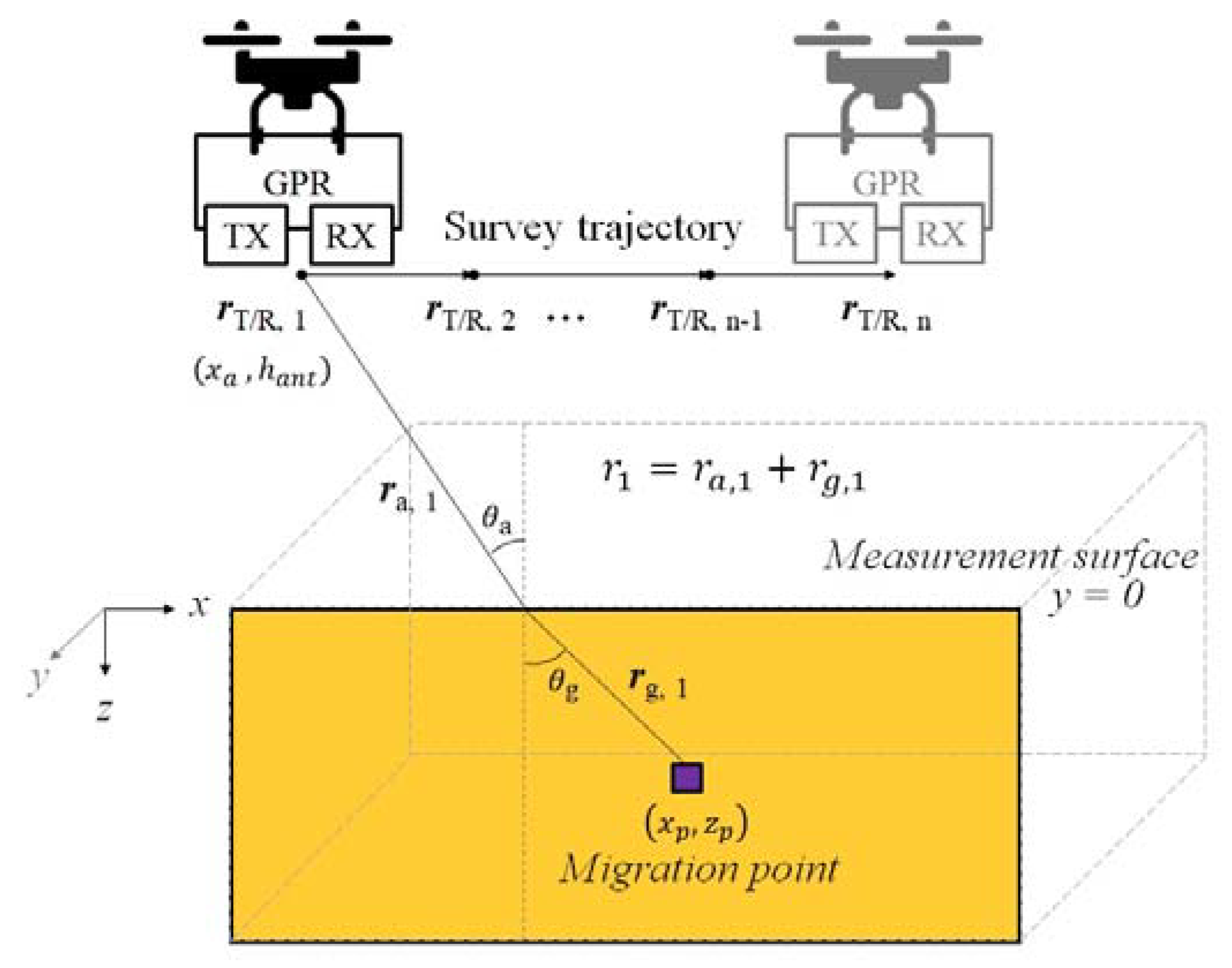
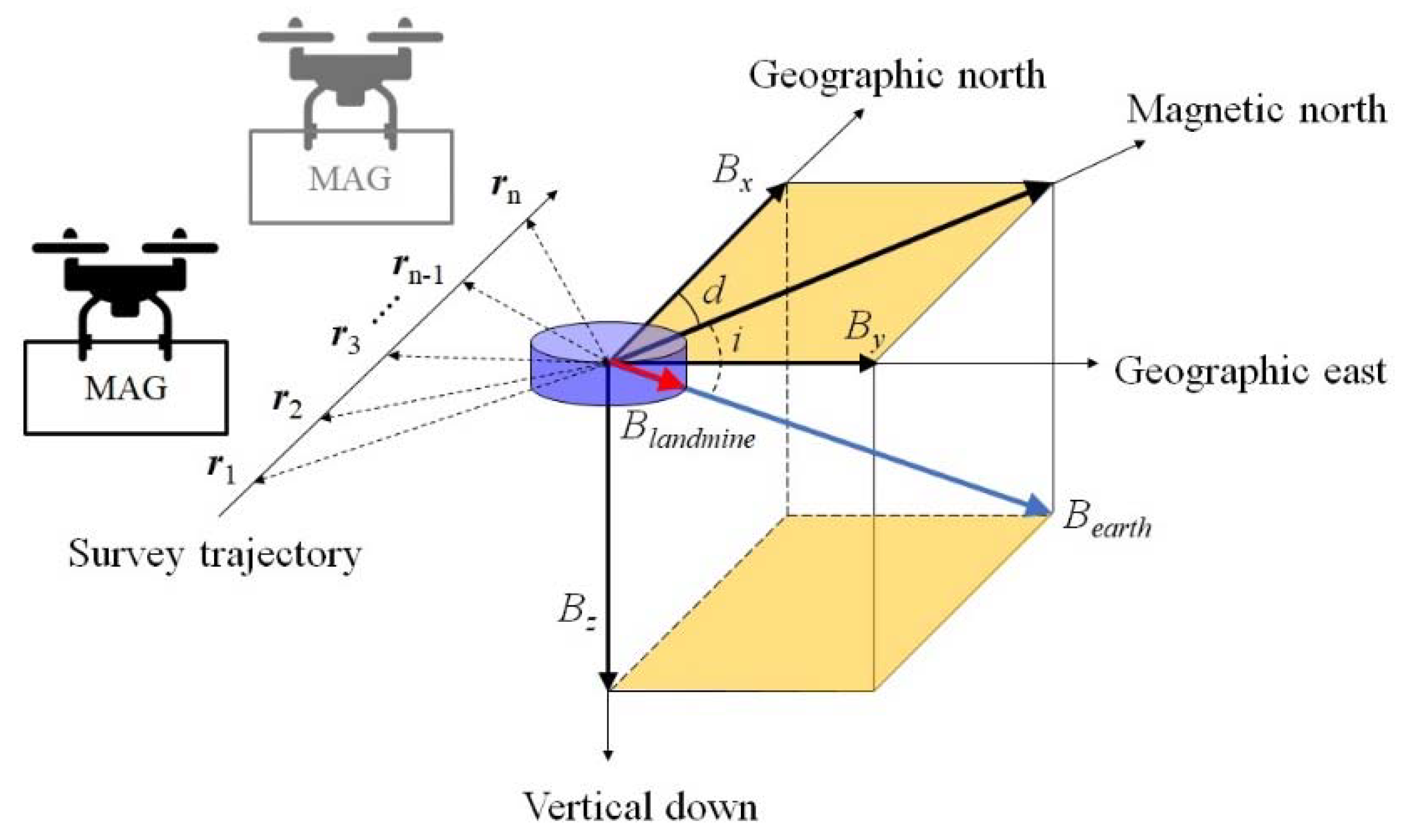

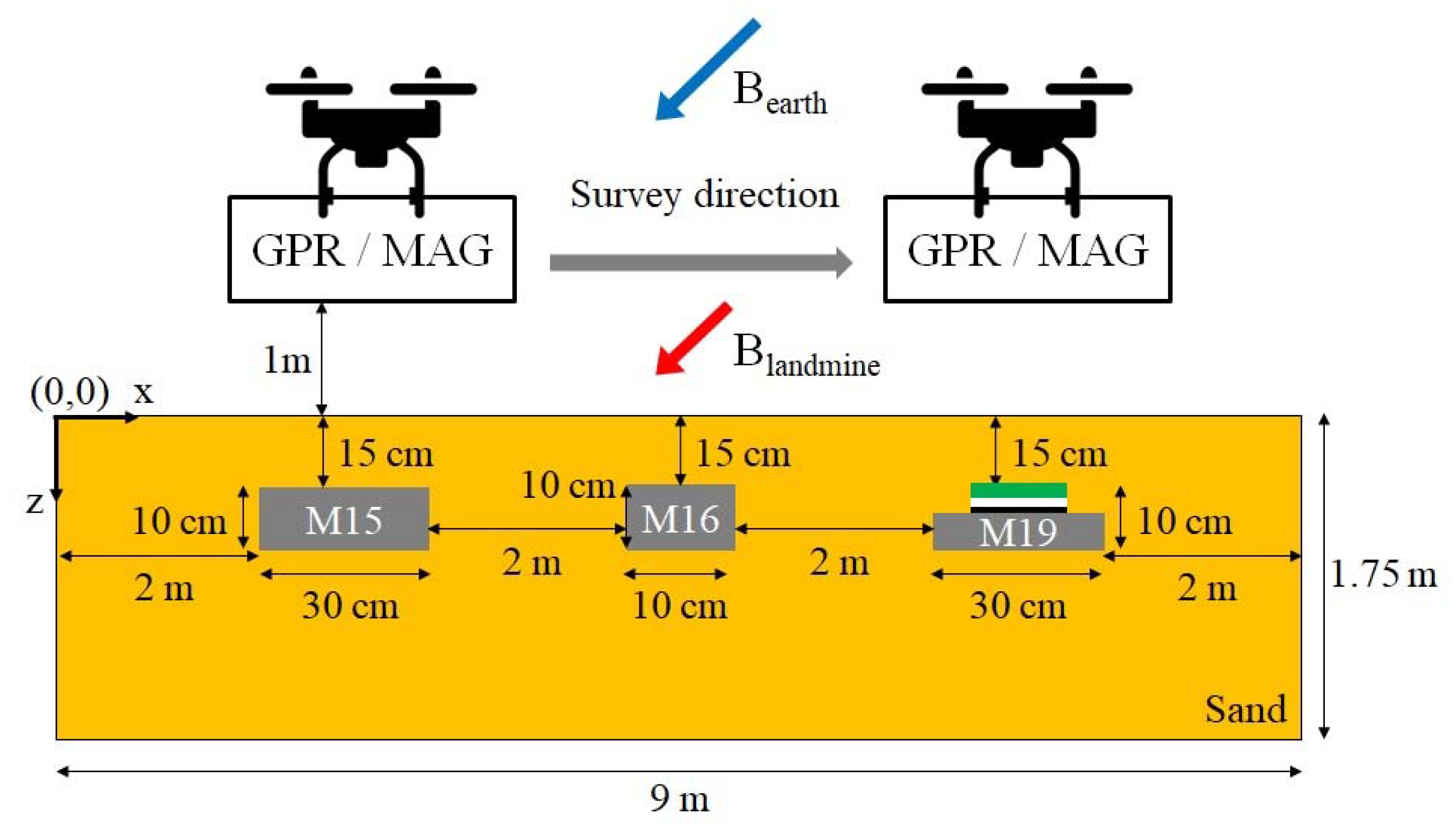
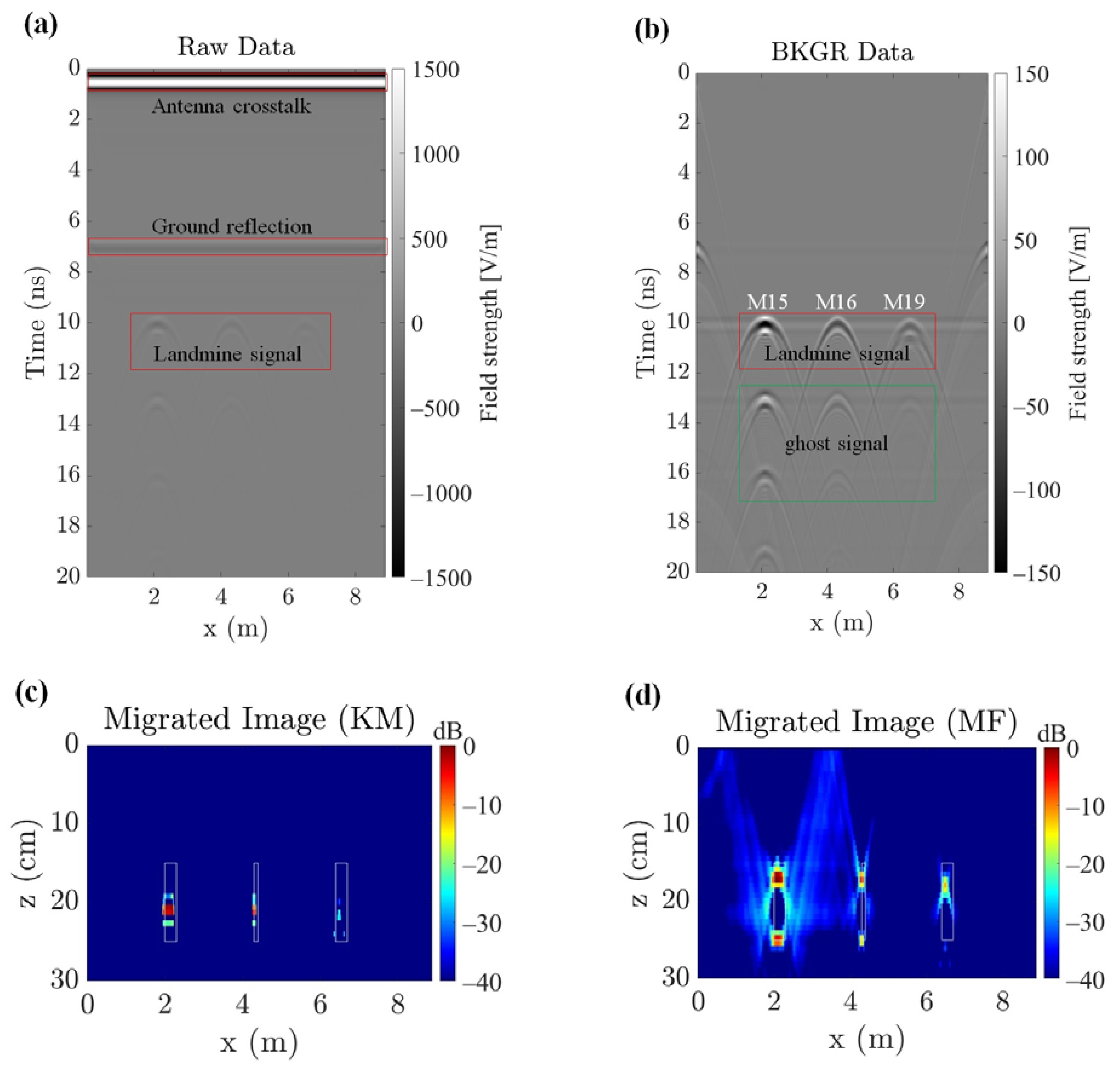
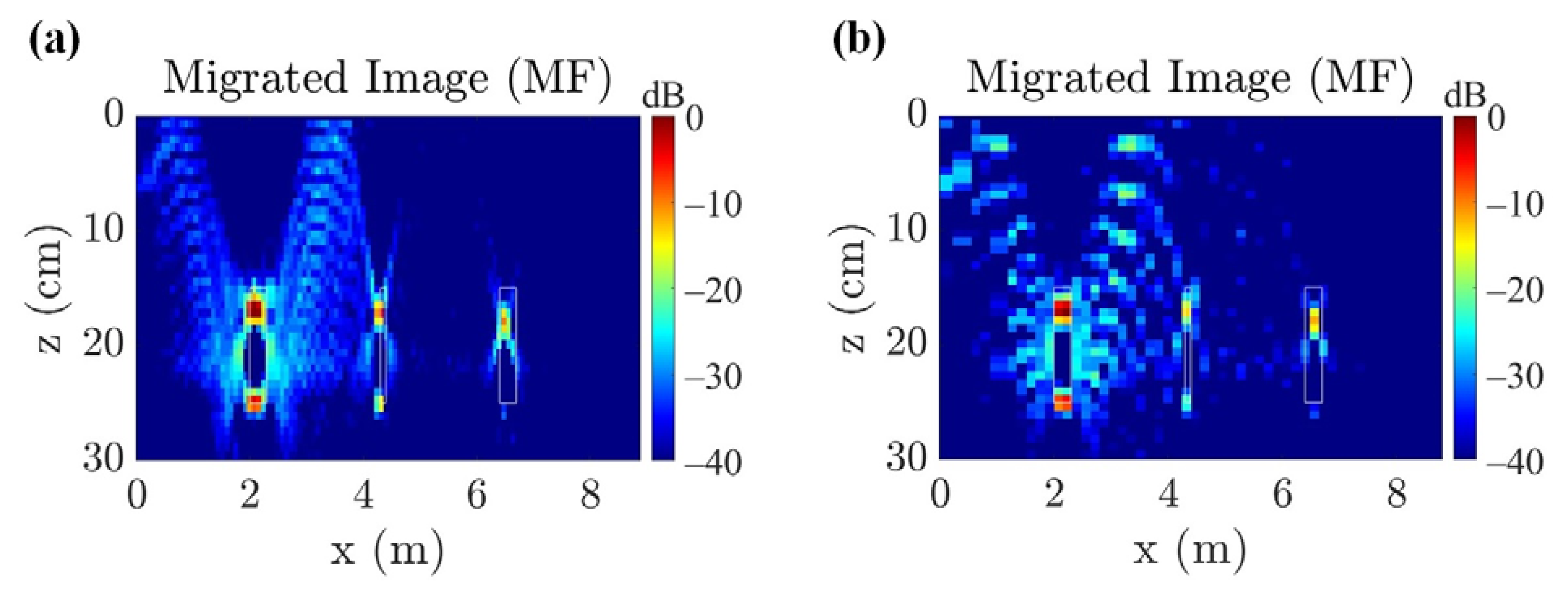
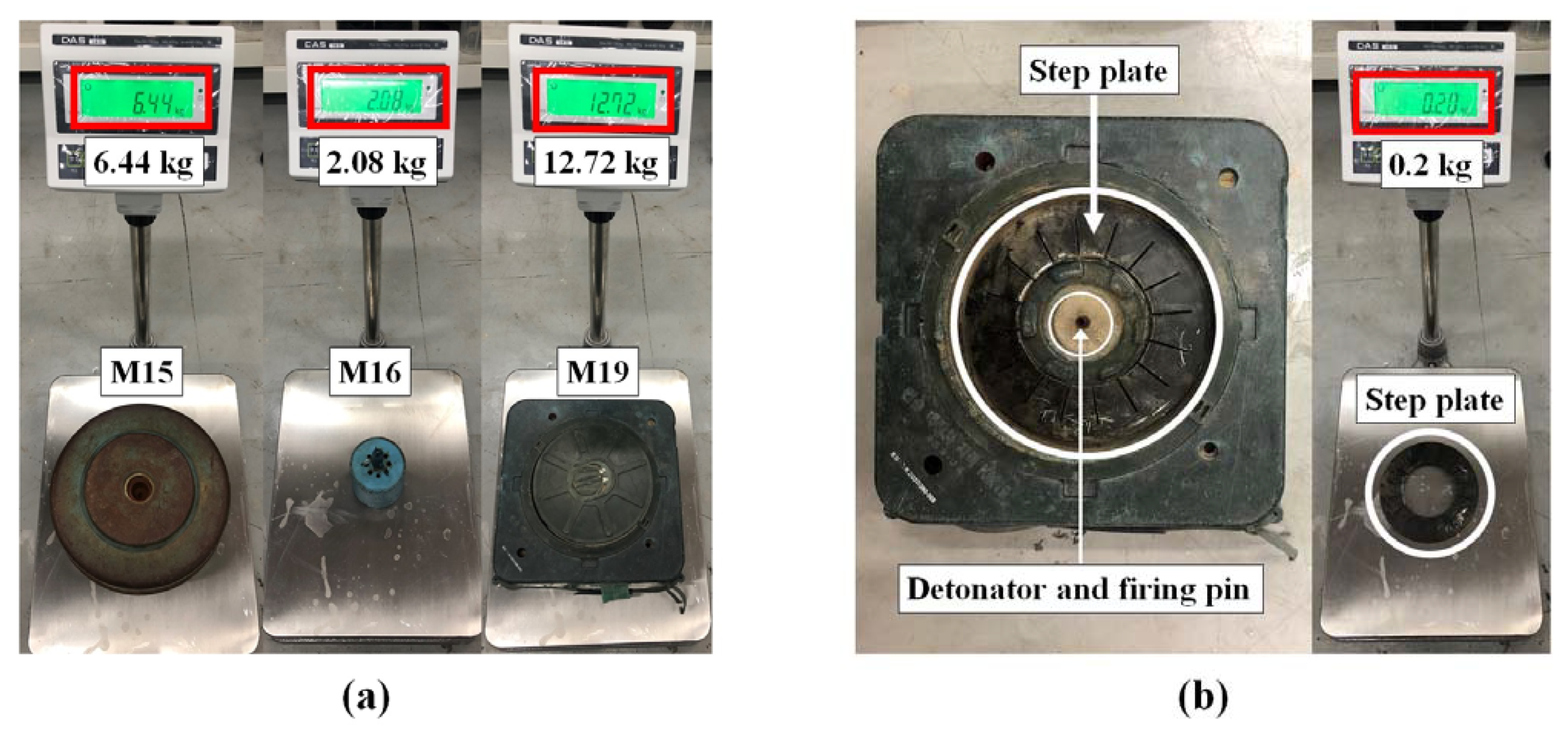
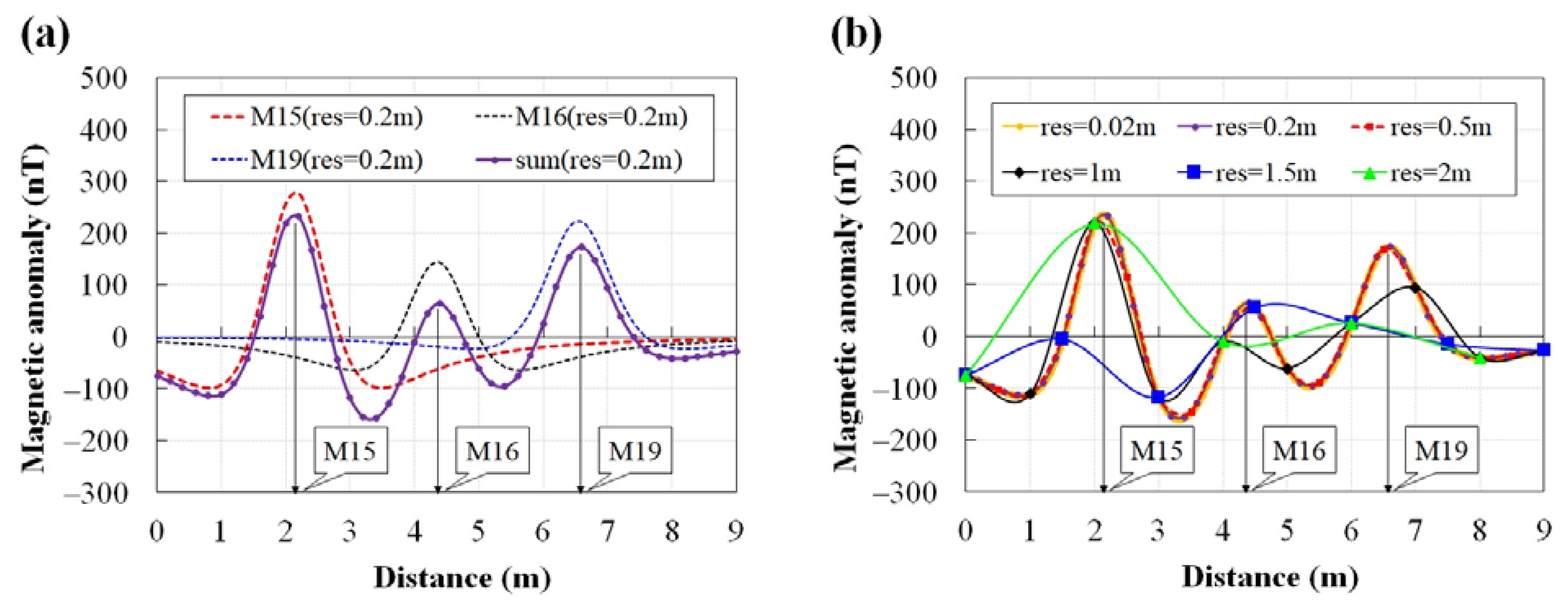
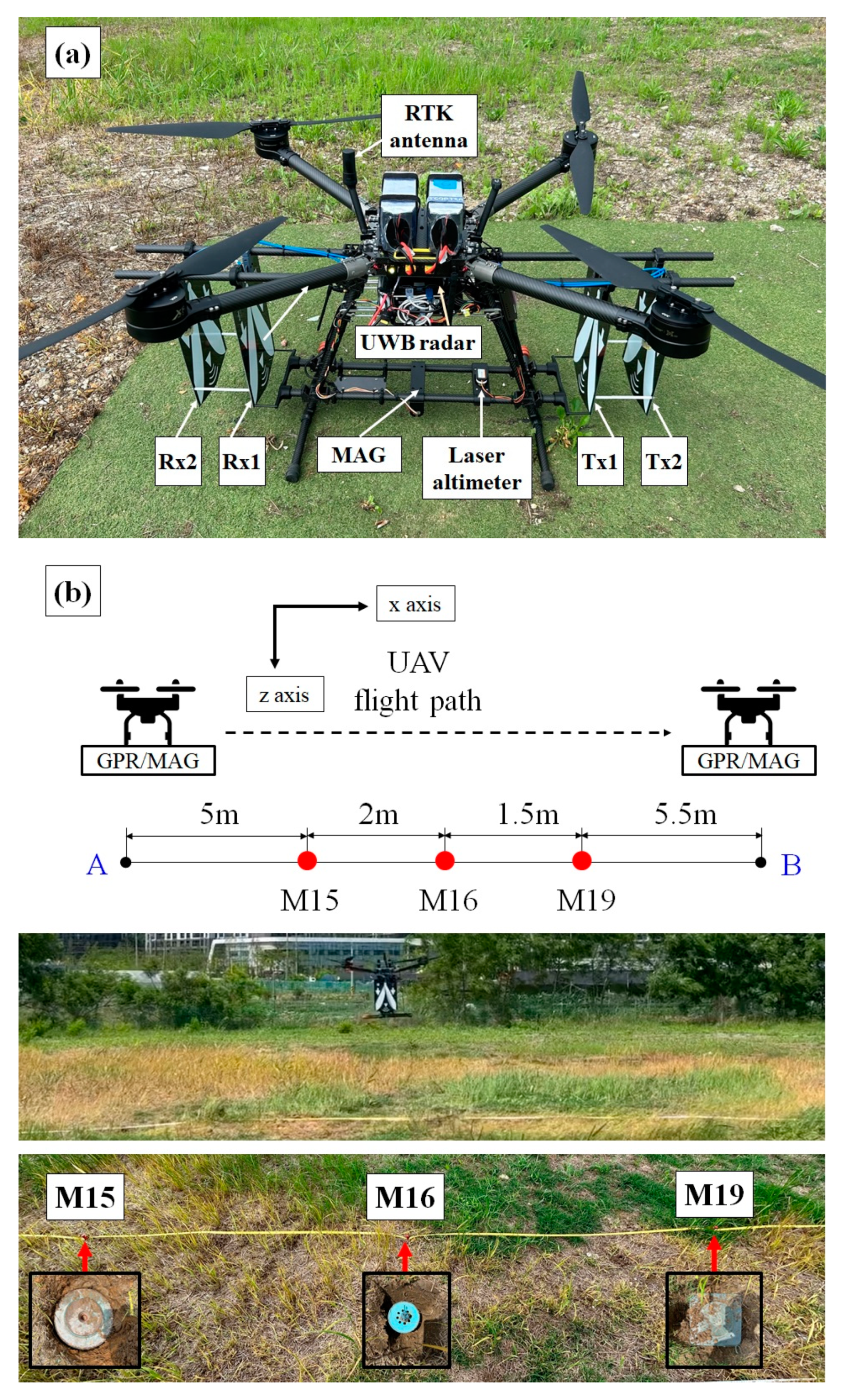
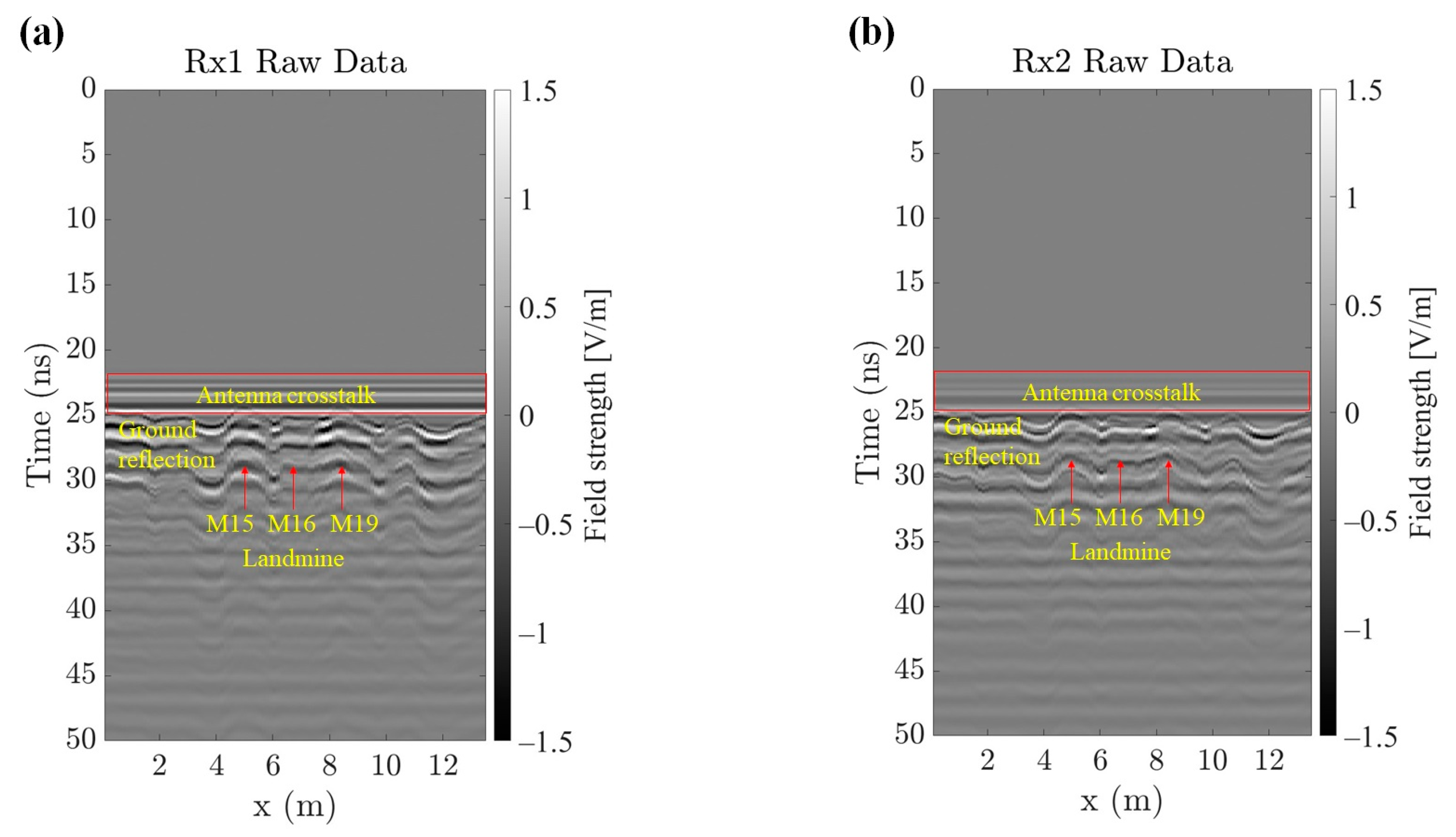
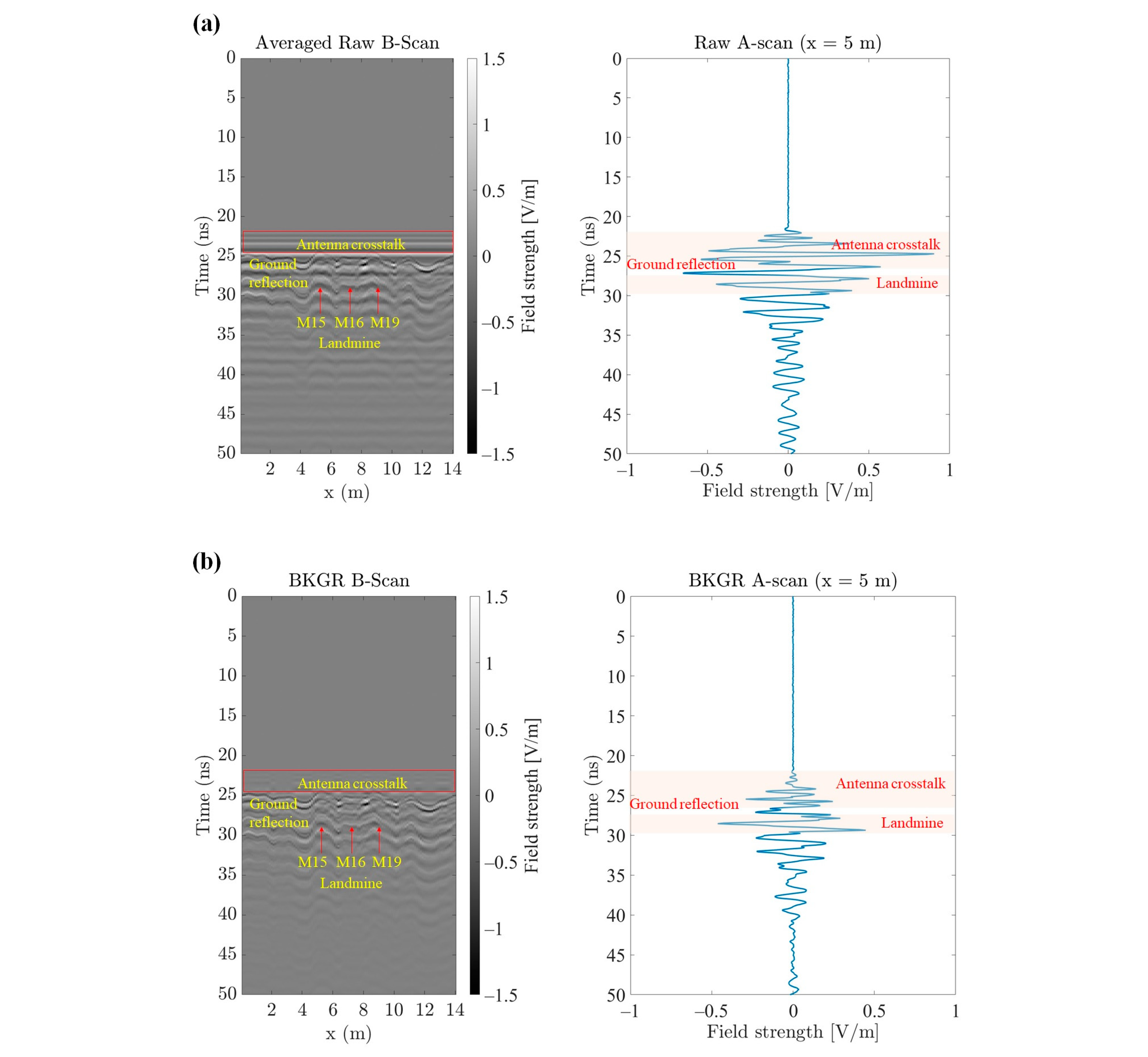
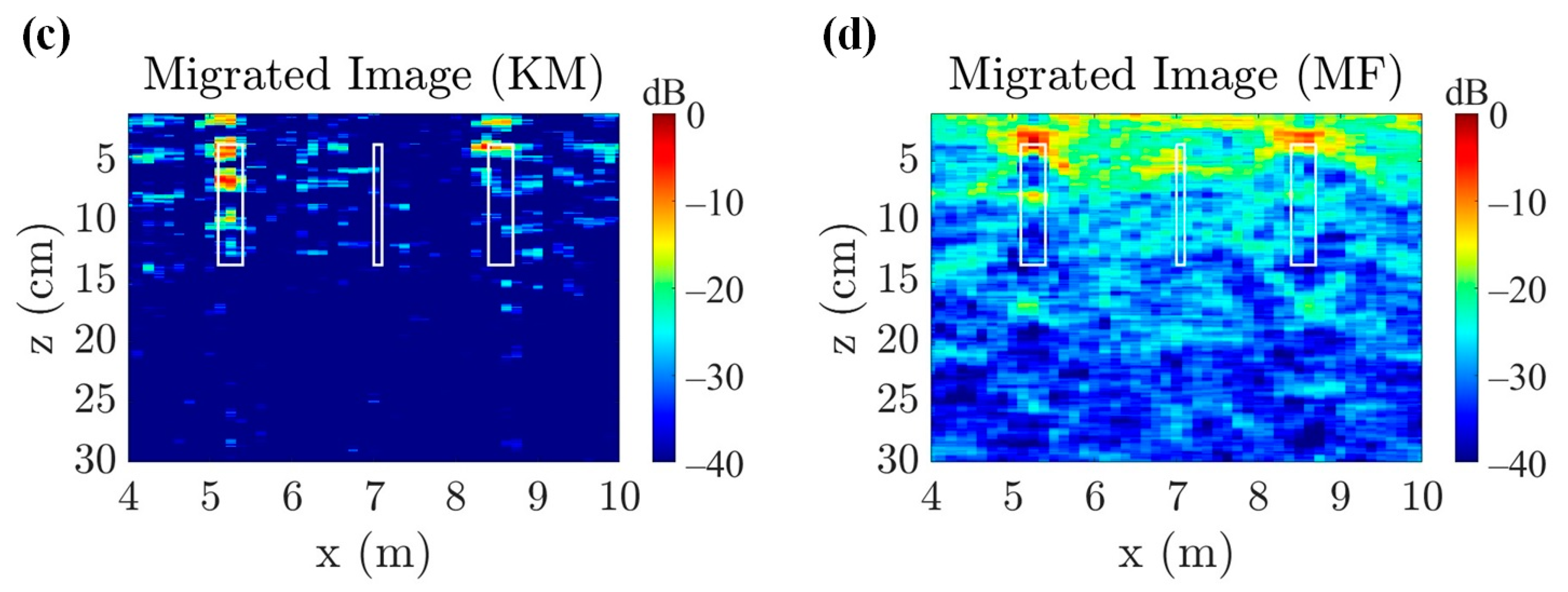
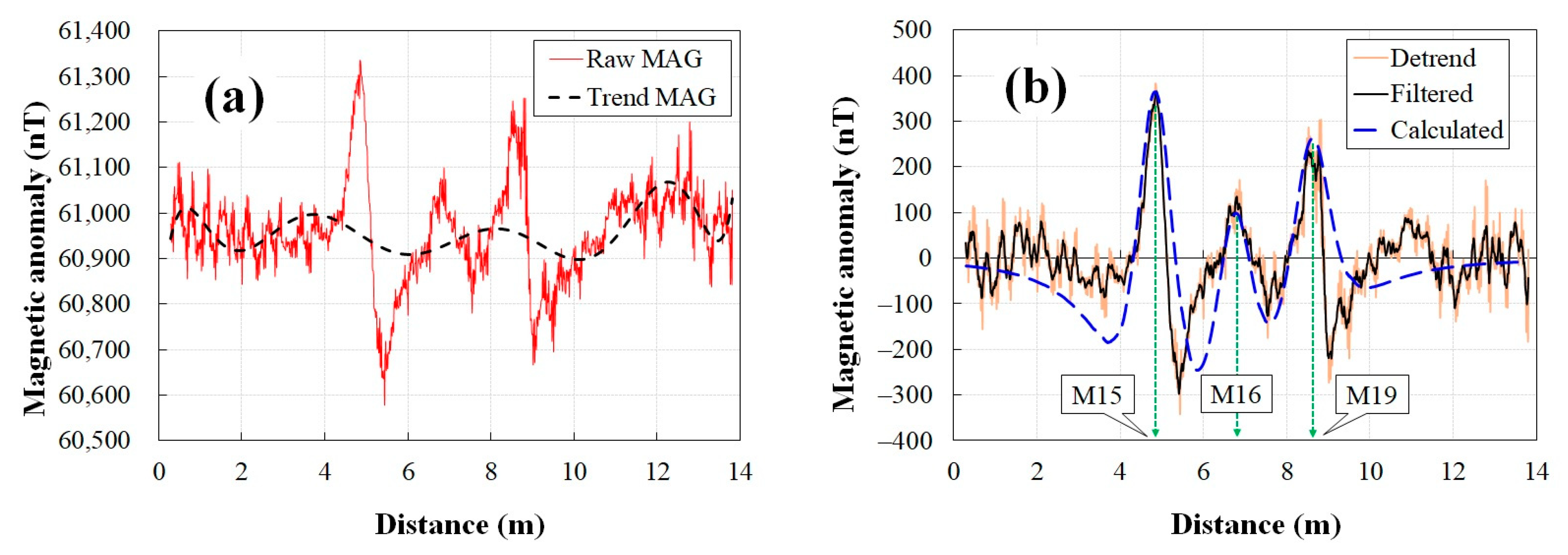
Disclaimer/Publisher’s Note: The statements, opinions and data contained in all publications are solely those of the individual author(s) and contributor(s) and not of MDPI and/or the editor(s). MDPI and/or the editor(s) disclaim responsibility for any injury to people or property resulting from any ideas, methods, instructions or products referred to in the content. |
© 2023 by the authors. Licensee MDPI, Basel, Switzerland. This article is an open access article distributed under the terms and conditions of the Creative Commons Attribution (CC BY) license (https://creativecommons.org/licenses/by/4.0/).
Share and Cite
Lee, J.; Lee, H.; Ko, S.; Ji, D.; Hyeon, J. Modeling and Implementation of a Joint Airborne Ground Penetrating Radar and Magnetometer System for Landmine Detection. Remote Sens. 2023, 15, 3813. https://doi.org/10.3390/rs15153813
Lee J, Lee H, Ko S, Ji D, Hyeon J. Modeling and Implementation of a Joint Airborne Ground Penetrating Radar and Magnetometer System for Landmine Detection. Remote Sensing. 2023; 15(15):3813. https://doi.org/10.3390/rs15153813
Chicago/Turabian StyleLee, Junghan, Haengseon Lee, Sunghyub Ko, Daehyeong Ji, and Jongwu Hyeon. 2023. "Modeling and Implementation of a Joint Airborne Ground Penetrating Radar and Magnetometer System for Landmine Detection" Remote Sensing 15, no. 15: 3813. https://doi.org/10.3390/rs15153813
APA StyleLee, J., Lee, H., Ko, S., Ji, D., & Hyeon, J. (2023). Modeling and Implementation of a Joint Airborne Ground Penetrating Radar and Magnetometer System for Landmine Detection. Remote Sensing, 15(15), 3813. https://doi.org/10.3390/rs15153813





